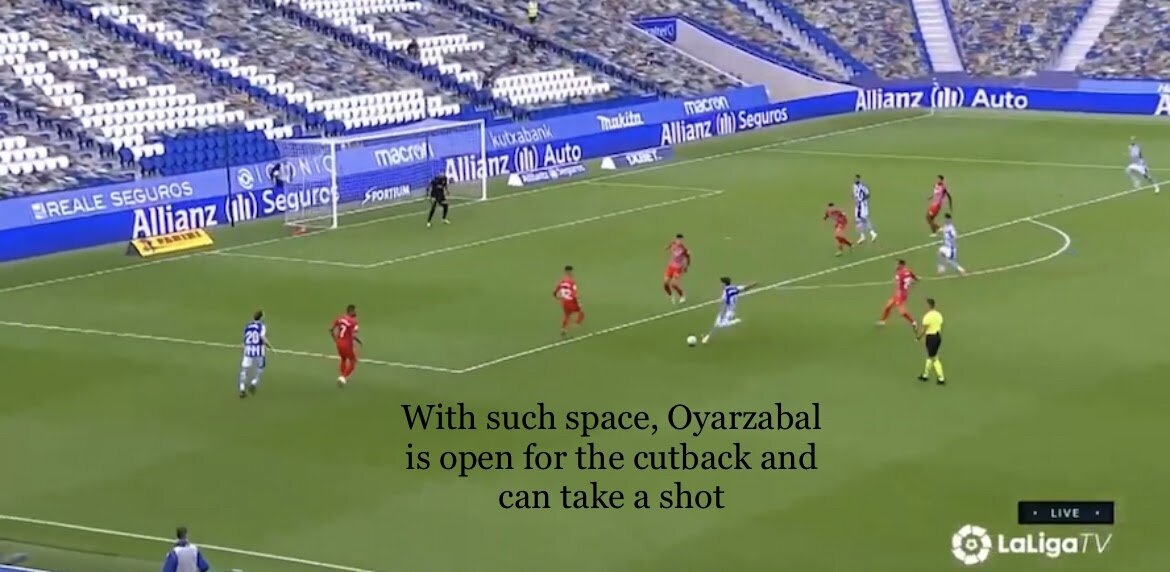Team Analysis: Real Sociedad’s positional play
Real Sociedad are enjoying a brilliant campaign and now currently sit-in 5th
Lately, Real Sociedad have hit a bit of a stump in terms of form having lost some consecutive La Liga matches and a UEL tie vs Manchester United. However, looking earlier into their season, they were topping the La Liga table surprisingly, while playing a quality brand of Positional Play. This article will be a case study on some of the patterns and noticeable about La Real’s Positional Play.
Many of the most effective and consistent teams that have utilized Positional Play are all gifted at playing between the lines, through opening and occupying spaces in the centre of the opposition’s defensive lines. Our first example is against La Real’s victory vs Granada, where Mikel Merino vacates the between the MID-DEF line of Granada. This interrupts Granada’s 4-2-3-1 block with one of the defensive midfielders stepping out opening space for Mikel Oyarzabal, where he laters gets a shot off a cutback with the space he has (example below)
We can also see how Jon Guridi stealthily unoccupied space between the lines, but this time to open a passing lane for Zubimendi to make the pass for the left winger, aided by Portu’s pinning of the LB and CB from closing down space.
Once again, the left side of Merino, Oyarzabal, and Monreal combine to play through the halfspaces and wide areas brilliantly, Mikel drops to receives the ball, attracts Granada player signalling Merino to occupy space as he receives with a two-touch to play to Monreal on the overlap. Third-man combos between the lines like this are what La Real execute perfectly.
Another element of La Real’s Positional Play doesn’t have to do with their most “skilful” and “gifted” players but allows those kinds of players to play their game because of the intelligence of these “pinners”. Pinning is an essential aspect of Positional Play in order to create space between the opposition’s MID-DEF lines, where most goal-scoring opportunities can be created. Alexander Isak, Willian Jose, and Cristian Portu are especially gifted at these runs. As we saw earlier, because of Portu’s pinning, Zubimendi could take advantage of the space vacated by Guridi between the lines.
Keeping the focus on Cristian Portu, watching his intelligent runs in-behind, as well as decoy runs, are a joy to watch. Completely out of the vision of the two CBs, he starts his run untypically early, catching the defenders off-guard because of how they can’t accelerate and act quick enough to catch him.
The discussion about La Real’s specific “tactics”, like formations and general positioning of players, aren’t exactly going to be harped upon because Real Sociedad’s formations and player positions are largely versatile and altered within certain contexts to create the most optimal superiorities. A small example, against Cadiz’s 4-4-2, La Real built out with 3 at the back while 2 at the back against Granada’s 4-2-3-1. 3v2, 2v1 in the last line. They adapt to the opponent but stay strict to their style of play.
Within wide areas, La Real do an excellent job to support superiorities, as you will almost always see an immediate underlap or overlap occurring. But the underlap is what is most impressive and tends to damage oppositions a lot more, because of the out-to-in dynamic, where a wide winger stretches the backline and creates space for a blindside underlap that penetrates into the final third.
Within more complicated contexts of superiorities, like within phase space, La Real utilizes the “the area of mutual help” to create wonderful third man combos, just like the combination shown with Merino, Oyarzabal, and Monreal earlier. Oftentimes seeing two players combine for a pass, attracting opponents, then a third man entering the area. This is often on the blindside of the pressuring players, providing a solution.
It’s important to note that one of the main reasons La Real is able to play this brand of football is because of its “gifted” or “differential” individuals in the middle of the park that almost always stamp on positional superiorities upon their opponents, easing the game for the whole. I’ve already mentioned an example of Merino’s brilliance, but another household name like David Silva truly changes the game for La Real, in ways like how he can eliminate several opponents within one pass.
Eliminates 6 players, two lines with one pass
Another differential player that can go under the radar is La Real’s young gun Martin Zubimendi, who displays an intelligent game seeing a play before anyone else, and establishing impressive positional superiorities that allow him to get out of sticky situations.
This video clip shows his use of the backfoot to fool a man-marker and get free in space, then playing a sublime pass wide.
In buildup, La Real possess a patient style that allows them to truly exploit defensive blocks. It seems that they don’t make “useless” passes, with an intention within most of them. What “intention” means is that even negative passes, like horizontal and back passes, are utilized to stretch the opposition vertically and horizontally to open forward and vertical passing lanes.
As you can see, the La Real buildup stays patient, passing horizontally until they attract the opponent into pressing, creating space and open gaps within their block as a result to progress forward
To conclude, this Real Sociedad side knows its Positional Play fundamentals and executes it beautifully, a style of play that allowed them to be very dangerous in the beginning of the season, and gives them the potential to be a force to be reckoned with.
Written by @/theblancotimes on Twitter
















